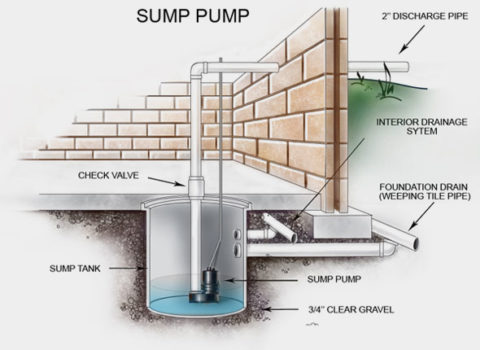
Remember July 8, 2013?
A record-breaking 126mm of rain fell in under 2 hours flooding Toronto.
How about May 3, 2012?
That was the day when Orangeville received 76.8mm of rain in less than 12 hours where, according to Environment Canada, the average rainfall is usually 75mm for an entire month of May.

Orangeville 2012 Flood
Even last year on August 12, 2014 an unseasonably amount of rain fell hard and fast taking many people by surprise.
We certainly remember those days and many more. And so do a lot of homeowners whose homes were flooded.
With summer upon us, we think of hot sunny days, outdoor activities and vacations. But it’s important to think of what’s inside the home as well and be prepared for those not so nice days.
During times of heavy rain we too get ‘flooded’ with emergency calls from so many people whose sump pumps had failed them. In fact, this is our second most common plumbing emergency. But water damage to floors, furniture and precious memories can be avoided or at least greatly reduced if the sump pump and pit are inspected before it’s too late. There are some things you can do now on your own to prepare for what’s coming.
1) Test Your Sump Pump – Test your pump by pouring a couple of buckets of water into the pit to see if it turns on and removes the water. The pump should come on when the water level reaches about 8 – 12 inches from the top. Testing should be done periodically throughout the year to ensure it’s working correctly. A sump pump’s life span is typically anywhere from 5 – 12 years, depending on a number of factors such as the quality of the pump, size and type of pump, how much water it has to move, maintenance, etc. If for example your pump is 10 years old, we would recommend installing a new one.
2) Clean The Pit – Make sure the pit is free of debris and loose pebbles so nothing can clog the pump just when you need it to work the most. IMPORTANT: Don’t forget to unplug the pump or turn off the power first before removing it. NEVER put your hands in the water with the power on, even if the pump is not working.
3) Check the Float – Ensure that the float is allowed to move freely to function correctly.
4) Go Outside – Quite frequently the discharge line can get blocked by gravel, leaves or other debris and cause the water to back up into your home. Also confirm it’s not broken or damaged.
5) Battery Back-Up Sump Pump – If you have a battery back-up sump pump, also check the battery. On average a battery lasts two to four years, depending upon quality and usage. During a power outage, a good quality pump and battery will continuously keep working for several hours. If you don’t have a battery back up sump pump, seriously consider getting one installed in case of a power outage which usually occurs during rain storms.
We repeatedly hear from people, “Oh, I don’t need a new sump pump or battery back-up pump. I’ve lived here for 20 years and it’s (flooding) never happened before.” Well, according to weather specialists, each year will see more and more frequent record-breaking storms. You can hope for the best but it’s best to prepare for the worst. If your sump pump is not working or is getting old, the best time to replace it is before the next big storm, not after it.
And finally, make sure your eavestroughs are clear and the downspouts are in good condition and directed away from your house so rainwater goes to where it should and not into your home.

Tip: If your pump is continuously running but no water is being pumped out, there’s probably a blockage somewhere. Turn off the power to the pump immediately to prevent the motor from burning out and check the above and/or call a professional.
For more tips or to find answers to your questions, please check out our Plumbing Tips page or FAQ. Have a specific question? Send us an email or a call!